A Scientific Review of Recycling Practices and Challenges for Autoclaved Aerated Concrete in Sustainable Construction
Abstract
1. Introduction
2. Research Method
2.1. Keyword Search
2.2. Data Visualisation
3. Literature Analysis Based on Scientometrics
3.1. Key Research Topics
3.2. Document Co-Citation Network
3.3. Reference Co-Occurrence Network
4. Analysis Results
4.1. Recycling Method in Powder Form
4.2. Recycling Method in Sand Form
4.3. Evaluation of Current Recycling Methods
4.4. Possible Reuse Methods
4.4.1. An Adsorbent for Treating Contaminated Water
4.4.2. Mixed Subgrade Materials
4.4.3. Biological Filter
4.5. Secondary Material Recipient
5. Discussion and Future Research Directions
6. Conclusions
Author Contributions
Funding
Data Availability Statement
Conflicts of Interest
References
- Yang, J.; Wang, F.; He, X.; Su, Y.; Wang, T.; Ma, M. Potential usage of porous autoclaved aerated concrete waste as eco-friendly internal curing agent for shrinkage compensation. J. Clean. Prod. 2021, 320, 128894. [Google Scholar] [CrossRef]
- Seddighi, F.; Pachideh, G.; Salimbahrami, S.B. A study of mechanical and microstructures properties of autoclaved aerated concrete containing nano-graphene. J. Build. Eng. 2021, 43, 103106. [Google Scholar] [CrossRef]
- Walczak, P.; Malolepszy, J.; Reben, M.; Szymanski, P.; Rzepa, K. Utilization of waste glass in autoclaved aerated concrete. In Procedia Engineering, Proceedings of the 15th German-Lithuanian-Polish Colloquium/Meeting of EURO-Working-Group on Operational Research in Sustainable Development and Civil Engineering, Poznan, Poland, 19–21 June 2015; Elsevier Science Bv: Amsterdam, The Netherlands, 2015; Volume 122, pp. 302–309. [Google Scholar] [CrossRef]
- Tang, T.; Cai, L.; You, K.; Liu, M.; Han, W. Effect of microwave pre-curing technology on carbide slag-fly ash autoclaved aerated concrete (CS-FA AAC): Porosity rough body formation, pore characteristics and hydration products. Constr. Build. Mater. 2020, 263, 120112. [Google Scholar] [CrossRef]
- Walczak, P.; Szymański, P.; Różycka, A. Autoclaved aerated concrete based on fly ash in density 350kg/m3 as an environmentally friendly material for energy-efficient constructions. Procedia Eng. 2015, 122, 39–46. [Google Scholar] [CrossRef]
- Sherin, K.; Saurabh, J. Review of autoclaved aerated concrete:-advantages and disadvantages. In Proceedings of the National Conference on Advanced Structural Materials and Methodologies in Civil Engineering (ASMMCE–2018), Mumbai, India, 23–24 March 2018; pp. 35–39. [Google Scholar]
- Murthi, P.; Sri, N.V.; Baig, M.M.; Sajid, M.A.; Kaveri, S. Development of green concrete using effective utilization of autoclaved aerated concrete brick trash as lightweight aggregate. Mater. Today Proc. 2022, 68, 1599–1608. [Google Scholar] [CrossRef]
- Yang, J.; Zeng, J.; He, X.; Su, Y.; Tan, H.; Min, H.; Hu, H.; Ye, H.; Ma, M.; Strnadel, B. Utilization of submicron autoclaved aerated concrete waste to prepare eco-friendly ultra-high performance concrete by replacing silica fume. J. Clean. Prod. 2022, 376, 134252. [Google Scholar] [CrossRef]
- Michelini, E.; Ferretti, D.; Miccoli, L.; Parisi, F. Autoclaved aerated concrete masonry for energy efficient buildings: State of the art and future developments. Constr. Build. Mater. 2023, 402, 132996. [Google Scholar] [CrossRef]
- Yang, J.; Zeng, L.; Su, Z.; He, X.; Su, Y.; Zhao, R.; Gan, X. Wet-milling disposal of autoclaved aerated concrete demolition waste–A comparison with classical supplementary cementitious materials. Adv. Powder Technol. 2020, 31, 3736–3746. [Google Scholar] [CrossRef]
- Steins, J.; Volk, R.; Kreft, O.; Schultmann, F. Post-demolition autoclaved aerated concrete in Germany until 2050—A forecast. Mauerwerk 2021, 25, 145–150. (In German) [Google Scholar] [CrossRef]
- Fudge, C.; Fouad, F.; Klingner, R. Autoclaved aerated concrete. In Developments in the Formulation and Reinforcement of Concrete; Elsevier: Amsterdam, The Netherlands, 2019; pp. 345–363. [Google Scholar]
- Kalpana, M.; Mohith, S. Study on autoclaved aerated concrete. Mater. Today Proc. 2020, 22, 894–896. [Google Scholar] [CrossRef]
- Hassan, A.; Alomayri, T.; Noaman, M.F.; Zhang, C. 3D Printed Concrete for Sustainable Construction: A Review of Mechanical Properties and Environmental Impact. Arch. Comput. Methods Eng. 2025, 32, 2713–2743. [Google Scholar] [CrossRef]
- Zou, D.J.; Que, Z.C.; Su, D.C.; Liu, T.J.; Zhou, A.; Li, Y. Sustainable use of recycled autoclaved aerated concrete waste as internal curing materials in ultra-high performance concrete. J. Clean. Prod. 2022, 373, 11. (In English) [Google Scholar] [CrossRef]
- Volk, R.; Steins, J.J.; Kreft, O.; Schultmann, F. Life cycle assessment of post-demolition autoclaved aerated concrete (AAC) recycling options. Resour. Conserv. Recycl. 2023, 188, 13. (In English) [Google Scholar] [CrossRef]
- Rahman, R.; Fazlizan, A.; Asim, N.; Thongtha, A. A review on the utilization of waste material for autoclaved aerated concrete production. J. Renew. Mater. 2021, 9, 61–72. [Google Scholar] [CrossRef]
- Qu, X.; Zhao, X. Previous and present investigations on the components, microstructure and main properties of autoclaved aerated concrete–A review. Constr. Build. Mater. 2017, 135, 505–516. [Google Scholar] [CrossRef]
- Shi, T.; Li, K.-M.; Wang, C.-Z.; Jin, Z.; Hao, X.-K.; Sun, P.; Han, Y.-X.; Pan, C.-G.; Fu, N.; Wang, H.-B. Fracture Toughness of Recycled Carbon Fibers Reinforced Cement Mortar and its Environmental Impact Assessment. Case Stud. Constr. Mater. 2025, 22, e04866. [Google Scholar] [CrossRef]
- Liu, Q.; Li, B.; Xiao, J.Z.; Singh, A. Utilization potential of aerated concrete block powder and clay brick powder from C&D waste. Constr. Build. Mater. 2020, 238, 12. (In English) [Google Scholar] [CrossRef]
- Steins, J.J.; Volk, R.; Schultmann, F. Modelling and predicting the generation of post-demolition autoclaved aerated concrete (AAC) volumes in Germany until 2050. Resour. Conserv. Recycl. 2021, 171, 105504. (In English) [Google Scholar] [CrossRef]
- Steins, J.J.; Ruck, M.; Volk, R.; Schultmann, F. Optimal design of a post-demolition autoclaved aerated concrete (AAC) recycling network using a capacitated, multi-period, and multi-stage warehouse location problem. J. Clean. Prod. 2024, 474, 143580. (In English) [Google Scholar] [CrossRef]
- Ma, Z.; Jiang, L.; Liao, H.; Cheng, F. Research on the methods for improving the compressive strength of solid waste-based high-strength autoclaved aerated concrete. Constr. Build. Mater. 2022, 361, 129645. [Google Scholar] [CrossRef]
- Harzing, A.-W.; Alakangas, S. Google Scholar, Scopus and the Web of Science: A longitudinal and cross-disciplinary comparison. Scientometrics 2016, 106, 787–804. [Google Scholar] [CrossRef]
- Santos, R.; Costa, A.A.; Grilo, A. Bibliometric analysis and review of Building Information Modelling literature published between 2005 and 2015. Autom. Constr. 2017, 80, 118–136. [Google Scholar] [CrossRef]
- Chen, C. Science mapping: A systematic review of the literature. J. Data Inf. Sci. 2017, 2, 1–40. [Google Scholar] [CrossRef]
- Chen, C. CiteSpace II: Detecting and visualizing emerging trends and transient patterns in scientific literature. J. Am. Soc. Inf. Sci. Technol. 2006, 57, 359–377. [Google Scholar] [CrossRef]
- Chen, C.; Song, M. Visualizing a field of research: A methodology of systematic scientometric reviews. PLoS ONE 2019, 14, e0223994. [Google Scholar] [CrossRef]
- Gyurkó, Z.; Jankus, B.; Fenyvesi, O.; Nemes, R. Sustainable applications for utilization the construction waste of aerated concrete. J. Clean. Prod. 2019, 230, 430–444. (In English) [Google Scholar] [CrossRef]
- Özalp, F.; Yılmaz, H.D.; Kara, M.; Kaya, Ö.; Şahin, A. Effects of recycled aggregates from construction and demolition wastes on mechanical and permeability properties of paving stone, kerb and concrete pipes. Constr. Build. Mater. 2016, 110, 17–23. [Google Scholar] [CrossRef]
- Gonzalez, M.; Tighe, S.L.; Hui, K.; Rahman, S.; de Oliveira Lima, A. Evaluation of freeze/thaw and scaling response of nanoconcrete for Portland Cement Concrete (PCC) pavements. Constr. Build. Mater. 2016, 120, 465–472. [Google Scholar] [CrossRef]
- Aprianti, E. A huge number of artificial waste material can be supplementary cementitious material (SCM) for concrete production–a review part II. J. Clean. Prod. 2017, 142, 4178–4194. [Google Scholar] [CrossRef]
- Schober, G. Porosity in autoclaved aerated concrete (AAC): A review on pore structure, types of porosity, measurement methods and effects of porosity on properties. In Proceedings of the 5th International Conference on Autoclaved Aerated Concrete, Leipzig, Germany, 14–16 September 2011; Volume 39, pp. 351–359. [Google Scholar]
- Kotake, N.; Kuboki, M.; Kiya, S.; Kanda, Y. Influence of dry and wet grinding conditions on fineness and shape of particle size distribution of product in a ball mill. Adv. Powder Technol. 2011, 22, 86–92. [Google Scholar] [CrossRef]
- He, X.Y.; Zheng, Z.Q.; Yang, J.; Su, Y.; Wang, T.W.; Strnadel, B. Feasibility of incorporating autoclaved aerated concrete waste for cement replacement in sustainable building materials. J. Clean. Prod. 2020, 250, 119455. (In English) [Google Scholar] [CrossRef]
- Strnadel, B.; Ma, M.; He, X.; Tan, H.; Wang, Y.; Su, Y.; Zheng, T.; Zhao, R. A comparative study on concrete slurry waste: Performance optimization from the wet-milling process. Mater. Struct. 2021, 54, 184. [Google Scholar] [CrossRef]
- Ye, H.; Zhu, B.; Pan, J.; Chen, X.; Qu, G. Solid waste-based low-carbon autoclaved aerated concrete: Relationship between engineering properties and microstructure. J. Build. Eng. 2024, 91, 109691. [Google Scholar] [CrossRef]
- Sobolev, K.; Lin, Z.; Cao, Y.; Sun, H.; Flores-Vivian, I.; Rushing, T.; Cummins, T.; Weiss, W.J. The influence of mechanical activation by vibro-milling on the early-age hydration and strength development of cement. Cem. Concr. Compos. 2016, 71, 53–62. [Google Scholar] [CrossRef]
- Cai, L.; Li, X.; Liu, W.; Ma, B.; Lv, Y. The slurry and physical-mechanical performance of autoclaved aerated concrete with high content solid wastes: Effect of grinding process. Constr. Build. Mater. 2019, 218, 28–39. [Google Scholar] [CrossRef]
- Yang, S.Z.; Wang, X.J.; Hu, Z.J.; Li, J.W.; Yao, X.L.; Zhang, C.; Wu, C.L.; Zhang, J.Z.; Wang, W.L. Recent advances in sustainable lightweight foamed concrete incorporating recycled waste and byproducts: A review. Constr. Build. Mater. 2023, 403, 133083. (In English) [Google Scholar] [CrossRef]
- Liu, Q.; Xiao, J.Z.; Singh, A. Plastic Shrinkage and Cracking Behavior of Mortar Containing Recycled Sand from Aerated Blocks and Clay Bricks. Sustainability 2021, 13, 1096. (In English) [Google Scholar] [CrossRef]
- Zou, D.J.; Que, Z.C.; Cui, W.; Wang, X.; Guo, Y.H.; Zhang, S.D. Feasibility of recycling autoclaved aerated concrete waste for partial sand replacement in mortar. J. Build. Eng. 2022, 52, 104481. (In English) [Google Scholar] [CrossRef]
- Gupta, S.; Kua, H.W. Effect of water entrainment by pre-soaked biochar particles on strength and permeability of cement mortar. Constr. Build. Mater. 2018, 159, 107–125. [Google Scholar] [CrossRef]
- Kumar, G.S. Influence of fluidity on mechanical and permeation performances of recycled aggregate mortar. Constr. Build. Mater. 2019, 213, 404–412. [Google Scholar] [CrossRef]
- Shrestha, A.R.; Xia, J.; Di Sarno, L.; Chen, C.S. Feasibility study of utilizing Autoclaved Aerated Concrete (AAC) waste for the production of cold bonded lightweight artificial aggregate using high volume fly ash (HVFA) binders. Constr. Build. Mater. 2024, 449, 138414. (In English) [Google Scholar] [CrossRef]
- BS EN 12390-3:2009; Testing Hardened Concrete: Compressive Strength of Test Specimens. British Standards Institution: London, UK, 2009.
- Hlawatsch, F.; Aycil, H.; Kropp, J. Autoclaved aerated concrete (AAC) rubble for new recycling building products: In dry premixed mortars for masonry, in masonry blocks and in lightweight blocks. Mauerwerk 2019, 23, 364–377. (In English) [Google Scholar] [CrossRef]
- Fenyvesi, O.; Jankus, B. Opportunities in recycling AAC waste as aggregate for lightweight concrete. Epitoanyag 2015, 67, 66–70. (In English) [Google Scholar] [CrossRef]
- Carsana, M.; Tittarelli, F.; Bertolini, L. Use of no-fines concrete as a building material: Strength, durability properties and corrosion protection of embedded steel. Cem. Concr. Res. 2013, 48, 64–73. [Google Scholar] [CrossRef]
- Liu, Q.; Singh, A.; Xiao, J.Z.; Li, B.; Tam, V.W. Workability and mechanical properties of mortar containing recycled sand from aerated concrete blocks and sintered clay bricks. Resour. Conserv. Recycl. 2020, 157, 104728. (In English) [Google Scholar] [CrossRef]
- Yusrianto, E.; Marsi, N.; Manaf, I.A.; Shariff, H.H. Performance of Autoclaved Aerated Concrete (AAC) Containing Recycled Ceramic and Gypsum Waste as Partial Replacement for Sand. Int. J. Nanoelectron. Mater. 2024, 17, 452–458. (In English) [Google Scholar] [CrossRef]
- Yang, F.H.; Zhu, Y.; Li, J.; Wang, C.L.; Ren, Z.Z.; Cui, X.W. Preparation and Performance of Energy-saving and Environment-friendly Autoclaved Aerated Concrete Prepared by Quartz Tailings Sand. J. New Mat.Electrochem. Syst. 2019, 22, 149–154. (In English) [Google Scholar] [CrossRef]
- Etxeberria, M.; Vázquez, E.; Marí, A.; Barra, M. Influence of amount of recycled coarse aggregates and production process on properties of recycled aggregate concrete. Cem. Concr. Res. 2007, 37, 735–742. [Google Scholar] [CrossRef]
- Pham, V.; Nguyen, T.D.; Nguyen, H.G.; Kawamoto, K. Mechanical, hydraulic, and particle breakage properties of recycled concrete aggregates blended with autoclaved aerated concrete (AAC) grains for unbound road base and subbase materials in Vietnam. J. Mater. Cycles Waste Manag. 2024, 26, 845–859. (In English) [Google Scholar] [CrossRef]
- Kreft, O. Closed-loop recycling of autoclaved aerated concrete. Mauerwerk 2016, 20, 183–190. [Google Scholar] [CrossRef]
- Kreft, O. Autoclaved aerated concrete with sulphate content: An environmentally friendly, durable and recyclable building material. Mauerwerk 2017, 21, 287–296. (In English) [Google Scholar] [CrossRef]
- Sun, D.S.; Huang, N.N.; Liu, K.W.; Tang, J.H.; Rong, N.; Wang, A.G.; Guan, Y.M.; Liang, P.L.; Deng, Y. Effect of recycled fine powder on autoclaved aerated concrete: Gas-foaming, physic-mechanical property and hydration products. J. Build. Eng. 2023, 67, 106013. (In English) [Google Scholar] [CrossRef]
- Lam, N.N. Influence of Fly Ash and Recycled AAC Waste for Replacement of Natural Sand in Manufacture of Autoclaved Aerated Concrete. In IOP Conference Series-Earth and Environmental Science, Proceedings of the 6th International Conference on Environment and Renewable Energy (ICERE), Hanoi, Vietnam, 28–30 September 2020; Iop Publishing Ltd.: Bristol, UK, 2020; Volume 505. [Google Scholar] [CrossRef]
- Lam, N.N. Recycling of Aac Waste in the Manufacture of Autoclaved Aerated Concrete in Vietnam. Int. J. GEOMATE 2021, 20, 128–134. (In English) [Google Scholar] [CrossRef]
- Jeswiet, J.; Szekeres, A. Energy consumption in mining comminution. Procedia CIRP 2016, 48, 140–145. [Google Scholar] [CrossRef]
- Nicolella, M.; Pino, A.; Scognamillo, C.; Vitale, F. Feasibility Study on the Production of Sustainable Mortars Packaged with Recycled AAC Aggregates. In IOP Conference Series-Materials Science and Engineering, Proceedings of the 5th World Multidisciplinary Civil Engineering-Architecture-Urban Planning Symposium (WMCAUS), Prague, Czech Republic, 15–19 June, 2020; Iop Publishing Ltd.: Bristol, UK, 2020; Volume 960. [Google Scholar] [CrossRef]
- Chowdhury, R.; Apul, D.; Fry, T. A life cycle based environmental impacts assessment of construction materials used in road construction. Resour. Conserv. Recycl. 2010, 54, 250–255. [Google Scholar] [CrossRef]
- Wei, M.; Chen, L.; Lei, N.; Li, H.; Huang, L. Mechanical properties and microstructures of thermally activated ultrafine recycled fine powder cementitious materials. Constr. Build. Mater. 2025, 475, 141195. [Google Scholar] [CrossRef]
- Zhang, W.; Lin, J.; Huang, Y.; Lin, B.; Liu, X. State of the art regarding interface bond behavior between FRP and concrete based on cohesive zone model. In Structures; Elsevier: Amsterdam, The Netherlands, 2025; Volume 74, p. 108528. [Google Scholar]
- Tran, S.H.; Tran, N.T.V.; Satoh, H.; Kawamoto, K. Characterization of Arsenic contaminated groundwater in Hanoi City and a treatment option by using recycled Autoclaved Aerated Concrete (AAC). Jpn. Geotech. Soc. Spec. Publ. 2021, 9, 226–233. [Google Scholar] [CrossRef]
- Kumara, G.M.P.; Kawamoto, K.; Saito, T.; Hamamoto, S.; Asamoto, S. Evaluation of Autoclaved Aerated Concrete Fines for Removal of Cd(II) and Pb(II) from Wastewater. J. Environ. Eng.-ASCE 2019, 145, 04019078. (In English) [Google Scholar] [CrossRef]
- Tran, H.S.; Viet, N.T.T.; Duong, T.H.; Nguyen, L.H.; Kawamoto, K. Autoclaved aerated concrete grains as alternative absorbent and filter media for phosphorus recovery from municipal wastewater: A case study in Hanoi, Vietnam. Environ. Technol. Innov. 2023, 31, 103175. [Google Scholar] [CrossRef]
- Zhang, Y.; Zeng, L.X.; Kang, Y.; Luo, J.W.; Li, W.J.; Zhang, Q.Y. Sustainable use of autoclaved aerated concrete waste to remove low concentration of Cd (II) ions in wastewater. Desalin. Water Treat. 2017, 82, 170–178. (In English) [Google Scholar] [CrossRef]
- Kuhn, D.C.; Cabral, L.L.; Pereira, I.C.; Gonçalves, A.J.; Maciel, G.M.; Haminiuk, C.W.I.; Nagalli, A.; Passig, F.H.; de Carvalho, K.Q. Development of aerated concrete waste/white cement composite for phosphate adsorption from aqueous solutions: Characterization and modeling studies. Chem. Eng. Process. 2023, 184, 109284. (In English) [Google Scholar] [CrossRef]
- Castellar, J.A.C.; Formosa, J.; Chimenos, J.M.; Canals, J.; Bosch, M.; Rosell, J.R.; Silva, H.P.; Morató, J.; Brix, H.; Arias, C.A. Crushed autoclaved aerated concrete (CAAC), a potential reactive filter medium for enhancing phosphorus removal in nature-based solutions—Preliminary batch studies. Water 2019, 11, 1442. [Google Scholar] [CrossRef]
- Shen, S.T.; Li, X.; Geng, Z.F.; Lu, X.W. Kinetics and capacities of non-reactive phosphorus (NRP) sorption to crushed autoclaved aerated concrete (CAAC). J. Environ. Sci. 2023, 127, 799–810. (In English) [Google Scholar] [CrossRef] [PubMed]
- Bergmans, J.; Nielsen, P.; Snellings, R.; Broos, K. Recycling of autoclaved aerated concrete in floor screeds: Sulfate leaching reduction by ettringite formation. Constr. Build. Mater. 2016, 111, 9–14. (In English) [Google Scholar] [CrossRef][Green Version]
- Renu; Agarwal, M.; Singh, K. Heavy metal removal from wastewater using various adsorbents: A review. J. Water Reuse Desalination 2017, 7, 387–419. [Google Scholar] [CrossRef]
- Zhao, M.; Xu, Y.; Zhang, C.; Rong, H.; Zeng, G. New trends in removing heavy metals from wastewater. Appl. Microbiol. Biotechnol. 2016, 100, 6509–6518. [Google Scholar] [CrossRef]
- Saleh, T.A.; Mustaqeem, M.; Khaled, M. Water treatment technologies in removing heavy metal ions from wastewater: A review. Environ. Nanotechnol. Monit. Manag. 2022, 17, 100617. [Google Scholar] [CrossRef]
- Behera, M.; Bhattacharyya, S.; Minocha, A.; Deoliya, R.; Maiti, S. Recycled aggregate from C&D waste & its use in concrete–A breakthrough towards sustainability in construction sector: A review. Constr. Build. Mater. 2014, 68, 501–516. [Google Scholar]
- Khalaf, F.M.; DeVenny, A.S. Recycling of demolished masonry rubble as coarse aggregate in concrete. J. Mater. Civ. Eng. 2004, 16, 331–340. [Google Scholar] [CrossRef]
- Altun, O.; Benzer, H.; Toprak, A.; Enderle, U. Utilization of grinding aids in dry horizontal stirred milling. Powder Technol. 2015, 286, 610–615. [Google Scholar] [CrossRef]
- Cong, X.; Tan, Y.; Lu, S.; Wang, Z.; Huang, T. Water absorptivity and frost resistance performance of self-ignition coal gangue autoclaved aerated concrete. J. Infrastruct. Preserv. Resil. 2021, 2, 15. [Google Scholar] [CrossRef]
- Thai, H.N.; Kawamoto, K.; Nguyen, H.G.; Sakaki, T.; Komatsu, T.; Moldrup, P. Measurements and modeling of thermal conductivity of recycled aggregates from concrete, clay brick, and their mixtures with autoclaved aerated concrete grains. Sustainability 2022, 14, 2417. [Google Scholar] [CrossRef]
- Bao, T.; Chen, T.H.; Wille, M.L.; Chen, D.; Bian, J.; Qing, C.S.; Wu, W.T.; Frost, R.L. Advanced wastewater treatment with autoclaved aerated concrete particles in biological aerated filters. J. Water Process. Eng. 2016, 9, 188–194. (In English) [Google Scholar] [CrossRef]
- Bao, T.; Chen, T.; Liu, H.; Chen, D.; Qing, C.; Frost, R.L. Preparation of magnetic porous ceramsite and its application in biological aerated filters. J. Water Process. Eng. 2014, 4, 185–195. [Google Scholar] [CrossRef]
- Kus, H.; Carlsson, T. Microstructural investigations of naturally and artificially weathered autoclaved aerated concrete. Cem. Concr. Res. 2003, 33, 1423–1432. [Google Scholar] [CrossRef]
- Li, Y.; Wang, J.; Lin, X.; Wang, H.; Li, H.; Li, J. Purification effects of recycled aggregates from construction waste as constructed wetland filler. J. Water Process. Eng. 2022, 50, 103335. [Google Scholar] [CrossRef]
- Bao, T.; Yu, Z.M.; Damtie, M.M.; Wu, K.; Jin, J.; Zhang, Y.; Wei, X.L.; Frost, R.L. Use of autoclaved aerated concrete particles for simultaneous removal of nitrogen and phosphorus as filter media from domestic wastewater. Environ. Technol. 2020, 41, 3032–3042. (In English) [Google Scholar] [CrossRef]
- Müller, A.; Martins, I. Recycling of Masonry Rubble. In Recycling of Building Materials: Generation-Processing-Utilization; Springer: Berlin, Germany, 2022; pp. 237–275. [Google Scholar]
- Li, W.J.; Zeng, L.X.; Kang, Y.; Zhang, Q.Y.; Luo, J.W.; Guo, X.M. A solid waste, crashed autoclaved aerated concrete, as a crystalline nucleus for the removal of low concentration of phosphate. Desalin. Water Treat. 2016, 57, 14169–14177. (In English) [Google Scholar] [CrossRef]
- Abou-Elela, S.I.; Hellal, M.S.; Abo-El-Enein, S.A. Utilization of autoclaved aerated concrete solid waste as a bio-carrier in immobilized bioreactor for municipal wastewater treatment. Desalin. Water Treat. 2019, 168, 108–116. (In English) [Google Scholar] [CrossRef]
- Stier, C.; Forberger, J. Survey Results about the Handling of Aerated Concrete from the Building Demolition. Chem. Ing. Tech. 2016, 88, 506–513. [Google Scholar] [CrossRef]
- Rahman, R.A.; Fazlizan, A.; Asim, N.; Thongtha, A. Utilization of waste material for aerated autoclaved concrete production: A preliminary review. In IOP Conference Series-Earth and Environmental Science, Proceedings of the International Conference on Sustainable Energy and Green Technology (SEGT), Bangkok, Thailand, 11–14 December 2019; Iop Publishing Ltd.: Bristol, UK, 2020; Volume 463. [Google Scholar] [CrossRef]
- Liu, Y.Q.; Leong, B.S.; Hu, Z.T.; Yang, E.H. Autoclaved aerated concrete incorporating waste aluminum dust as foaming agent. Constr. Build. Mater. 2017, 148, 140–147. (In English) [Google Scholar] [CrossRef]
- Wu, Y.P.; Wang, Y.H.; Han, W.S.; Yao, Y.H. Evaluating the utilization of municipal solid waste incineration ash in enhancing ceramsite aerated concrete blocks. Alex. Eng. J. 2025, 114, 292–299. (In English) [Google Scholar] [CrossRef]
- He, T.S.; Xu, R.S.; Da, Y.Q.; Yang, R.H.; Chen, C.; Liu, Y. Experimental study of high-performance autoclaved aerated concrete produced with recycled wood fibre and rubber powder. J. Clean. Prod. 2019, 234, 559–567. (In English) [Google Scholar] [CrossRef]
- El-Didamony, H.; Amer, A.A.; Mohammed, M.S.; Abd El-Hakim, M. Fabrication and properties of autoclaved aerated concrete containing agriculture and industrial solid wastes. J. Build. Eng. 2019, 22, 528–538. (In English) [Google Scholar] [CrossRef]
- Wang, C.Q.; Xiong, D.M. Leaching assessment of aerated concrete made of recycled shale gas drilling cuttings: Particular pollutants, physical performance and environmental characterization. J. Clean. Prod. 2021, 282, 125099. (In English) [Google Scholar] [CrossRef]
- Shams, T.; Schober, G.; Heinz, D.; Seifert, S. Possibility to Optimize Hydrothermal Conditions for the Production of Autoclaved Aerated Concrete Using Rice Husk Ash as the Silica Raw Material. In Lecture Notes in Civil Engineering, Proceedings of the 2nd International Civil Engineering and Architecture Conference (CEAC), null, Electr Network, 11–14 March 2022; Springer: Thong Teck Building, Singapore, 2023; pp. 3–11. [Google Scholar] [CrossRef]
- Shams, T.; Schober, G.; Heinz, D.; Seifert, S. Rice husk ash as a silica source for the production of autoclaved aerated concrete-A chance to save energy and primary resources. J. Build. Eng. 2022, 57, 104810. (In English) [Google Scholar] [CrossRef]
- Xu, R.S.; Tong, H.; Kong, F.H.; Yang, R.H.; Zhang, G.; Liu, W.Y.; Zhang, Z.M. Potential of copper tailings as supplementary siliceous materials in the preparation of autoclaved aerated concrete. J. Build. Eng. 2024, 98, 111250. (In English) [Google Scholar] [CrossRef]
- Lin, G.; Wang, C.L.; Qiao, C.Y.; Cui, H.L.; Chen, L.; Yu, S. Preparation and Properties of Autoclaved Aerated Concrete Containing Lead-Zinc Tailings. Rev. Rom. Mat. 2016, 46, 334–342. (In English) [Google Scholar]
- Wang, C.L.; Ni, W.; Zhang, S.Q.; Wang, S.; Gai, G.S.; Wang, W.K. Preparation and properties of autoclaved aerated concrete using coal gangue and iron ore tailings. Constr. Build. Mater. 2016, 104, 109–115. (In English) [Google Scholar] [CrossRef]
- Yang, F.H.; Liang, X.Y.; Zhu, Y.; Wang, C.L.; Zhao, G.F.; Cui, X.W. Preparation of Environmentally Friendly and Energy-saving Autoclaved Aerated Concrete using Gold Tailings. J. New Mat. Electrochem. Syst. 2019, 22, 159–164. (In English) [Google Scholar] [CrossRef]
- Chen, Y.L.; Lin, C.T. Recycling of Basic Oxygen Furnace Slag as a Raw Material for Autoclaved Aerated Concrete Production. Sustainability 2020, 12, 5896. (In English) [Google Scholar] [CrossRef]
- Chen, Y.L.; Ko, M.S.; Chang, J.E.; Lin, C.T. Recycling of desulfurization slag for the production of autoclaved aerated concrete. Constr. Build. Mater. 2018, 158, 132–140. (In English) [Google Scholar] [CrossRef]
- Liang, X.Y.; Wang, C.L.; Zhan, J.Y.; Cui, X.W.; Ren, Z.Z. Study on Preparation of Eco-friendly Autoclaved Aerated Concrete from Low Silicon and High Iron Ore Tailings. J. New Mat. Electrochem. Syst. 2019, 22, 224–230. (In English) [Google Scholar] [CrossRef]
- Cui, X.W.; Wang, C.L.; Ni, W.; Di, Y.Q.; Cui, H.L.; Chen, L. Study on the Reaction Mechanism of Autoclaved Aerated Concrete Based on Iron Ore Tailings. Rev. Rom. Mat. 2017, 47, 46–53. (In English) [Google Scholar]
- Song, Q.; Bao, J.W.; Xue, S.B.; Zhang, P.; Han, X.Y. Study on the recycling of ceramic polishing slag in autoclaved aerated foam concrete by response surface methodology. J. Build. Eng. 2022, 56, 104827. (In English) [Google Scholar] [CrossRef]
- Ma, S.C.; Kong, Y.H.; Li, L.; Lu, R.; Liu, Z.S.; Xia, Z.L.; Ma, J.X. Technical innovation of Autoclaved Aerated Concrete preparation from Desulfurization Wastewater and Sludge and its Life Cycle Assessment. Energy Sources Part A: Recovery Util. Environ. Eff. 2023, 45, 12759–12773. (In English) [Google Scholar] [CrossRef]
- Wu, R.D.; Dai, S.B.; Jian, S.W.; Huang, J.; Tan, H.B.; Li, B.D. Utilization of solid waste high-volume calcium coal gangue in autoclaved aerated concrete: Physico-mechanical properties, hydration products and economic costs. J. Clean. Prod. 2021, 278, 123416. (In English) [Google Scholar] [CrossRef]
- Chen, D.; Zhang, P.; Pan, T.; Liao, Y.; Zhao, H. Evaluation of the eco-friendly crushed waste oyster shell mortars containing supplementary cementitious materials. J. Clean. Prod. 2019, 237, 117811. [Google Scholar] [CrossRef]
- Liao, Y.; Fan, J.; Li, R.; Da, B.; Chen, D.; Zhang, Y. Influence of the usage of waste oyster shell powder on mechanical properties and durability of mortar. Adv. Powder Technol. 2022, 33, 103503. [Google Scholar] [CrossRef]
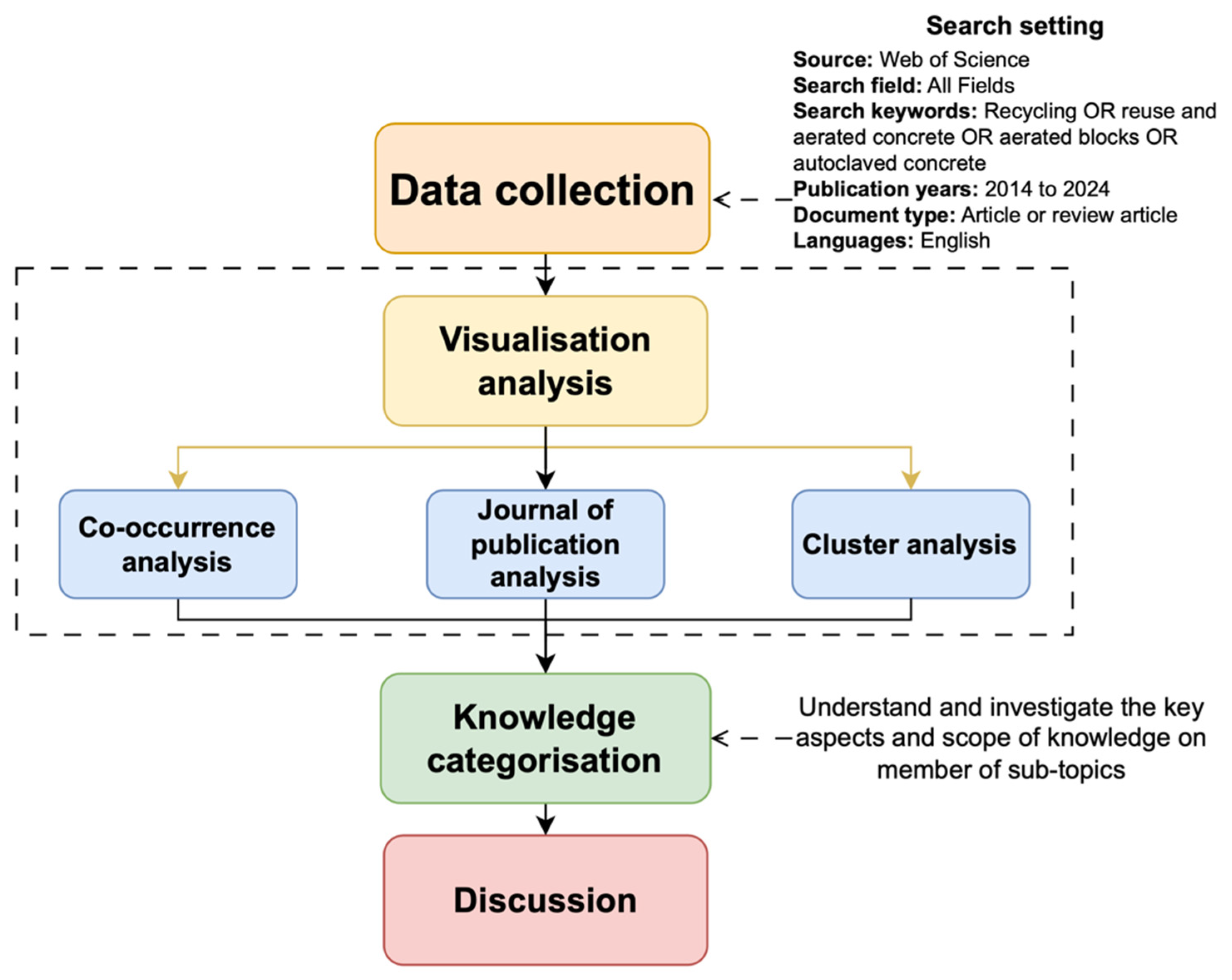
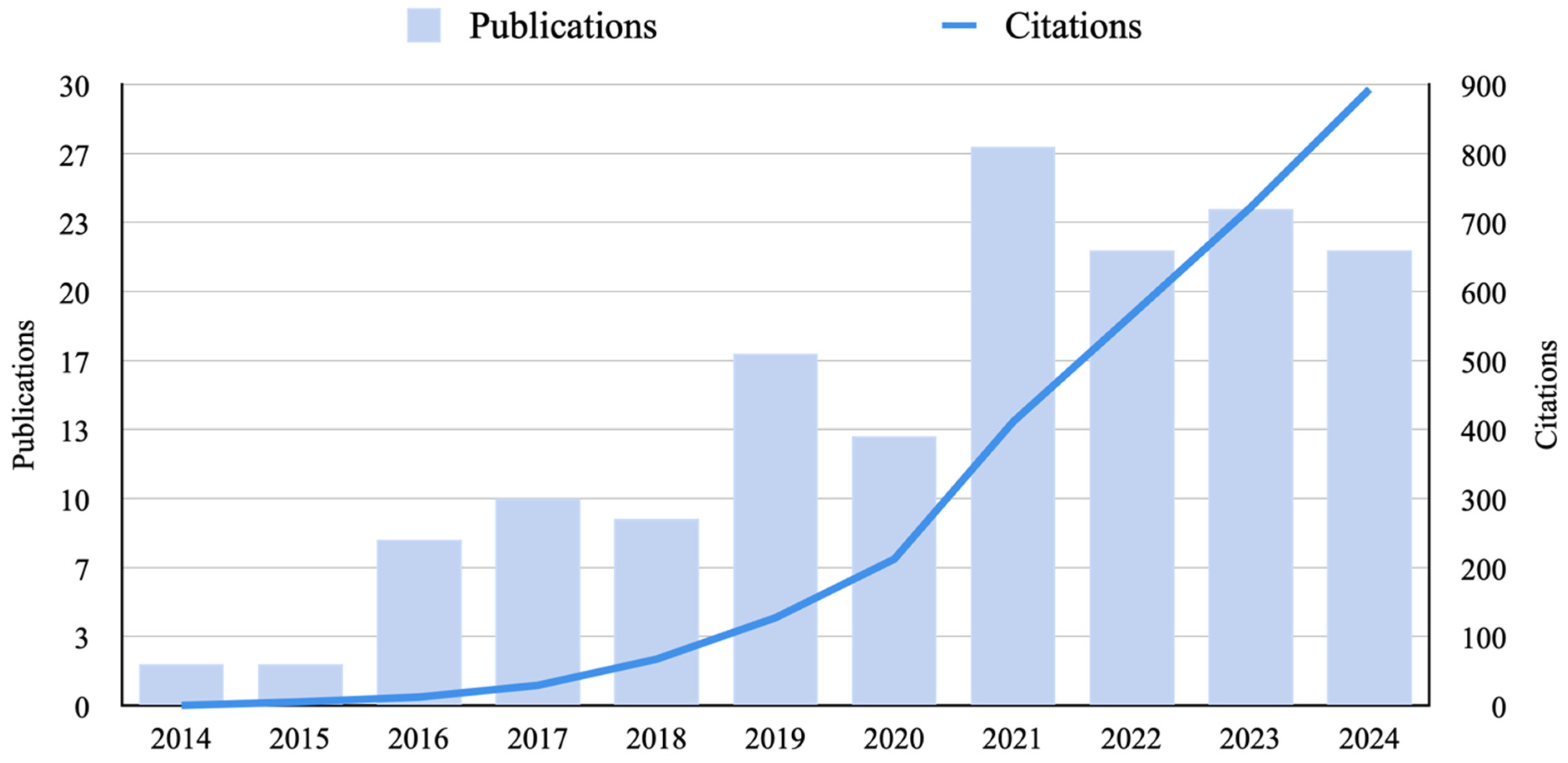
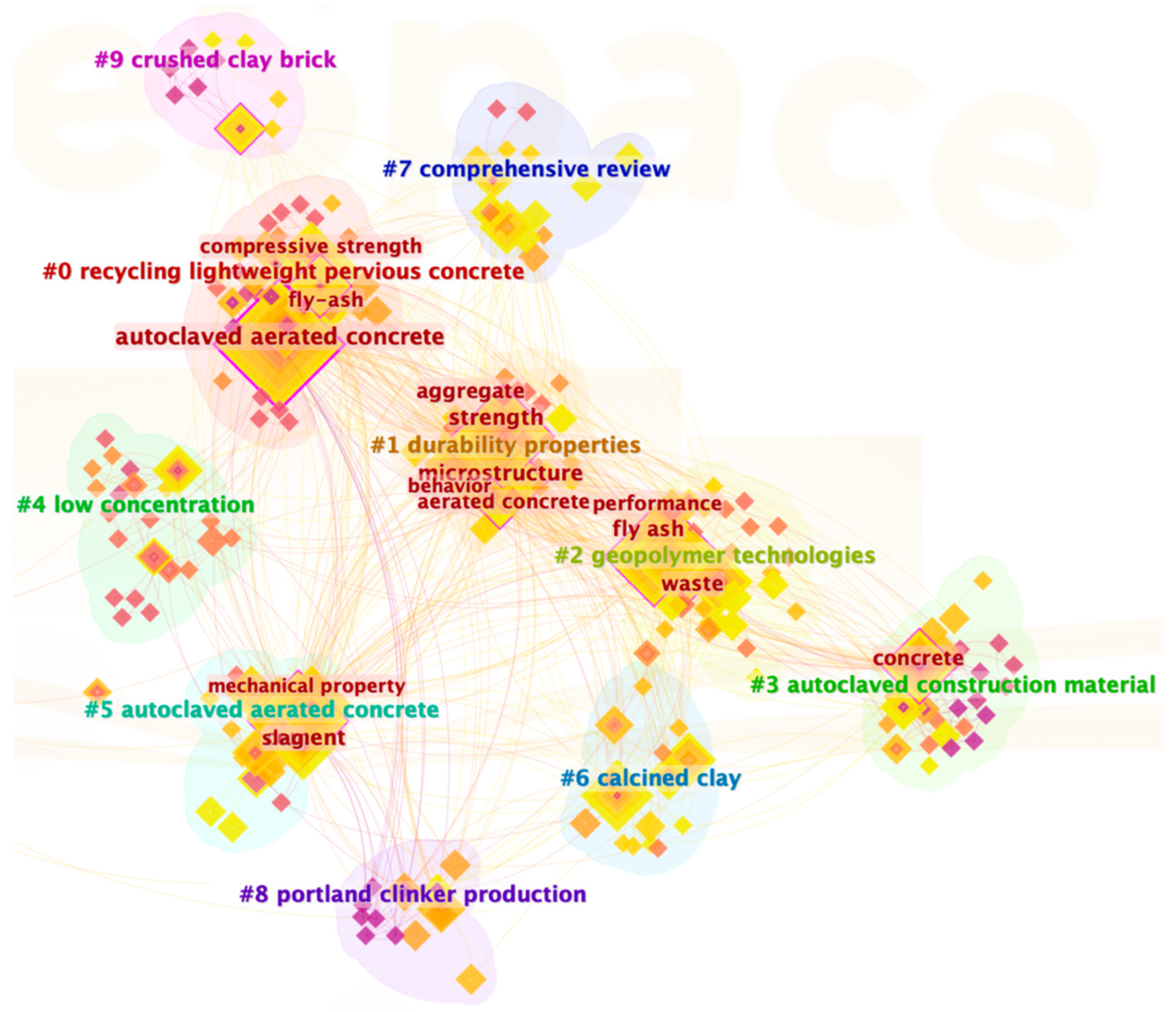
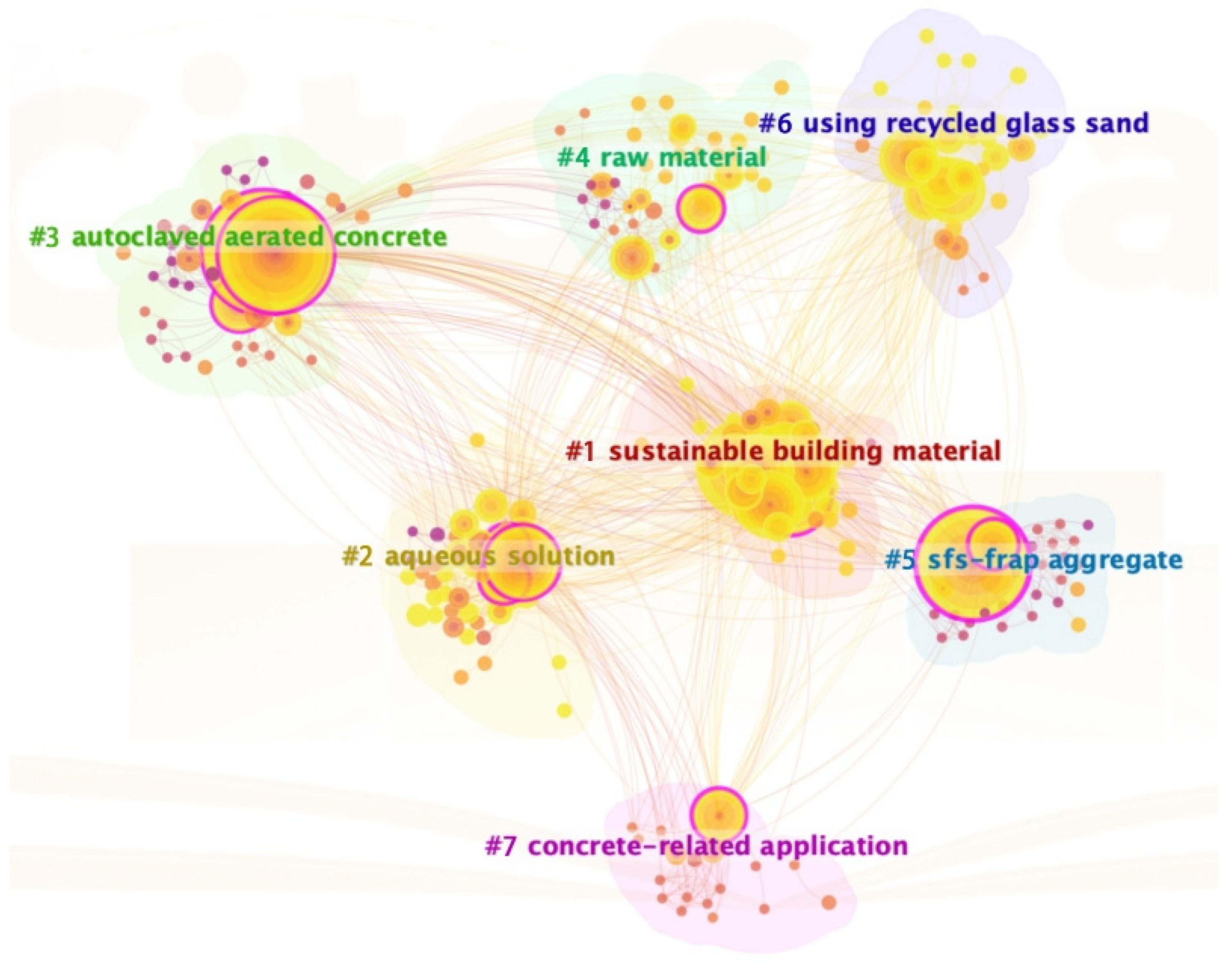

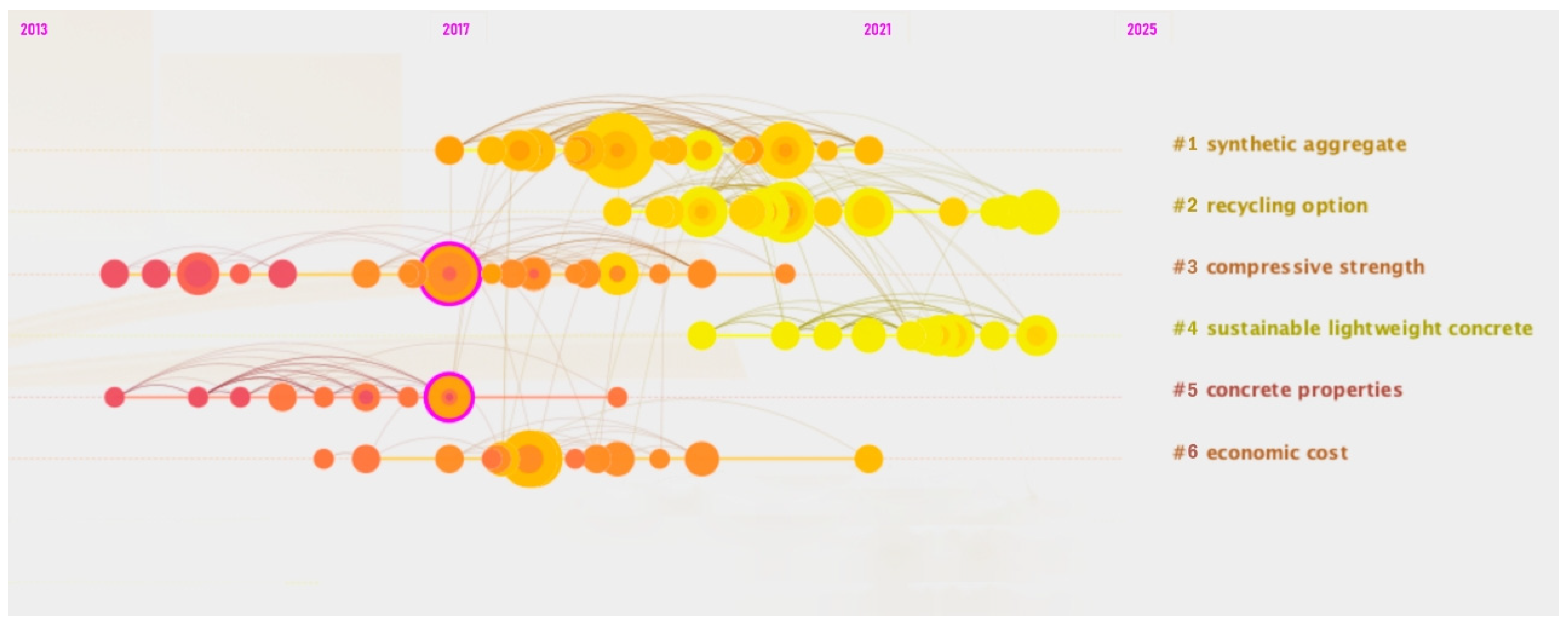
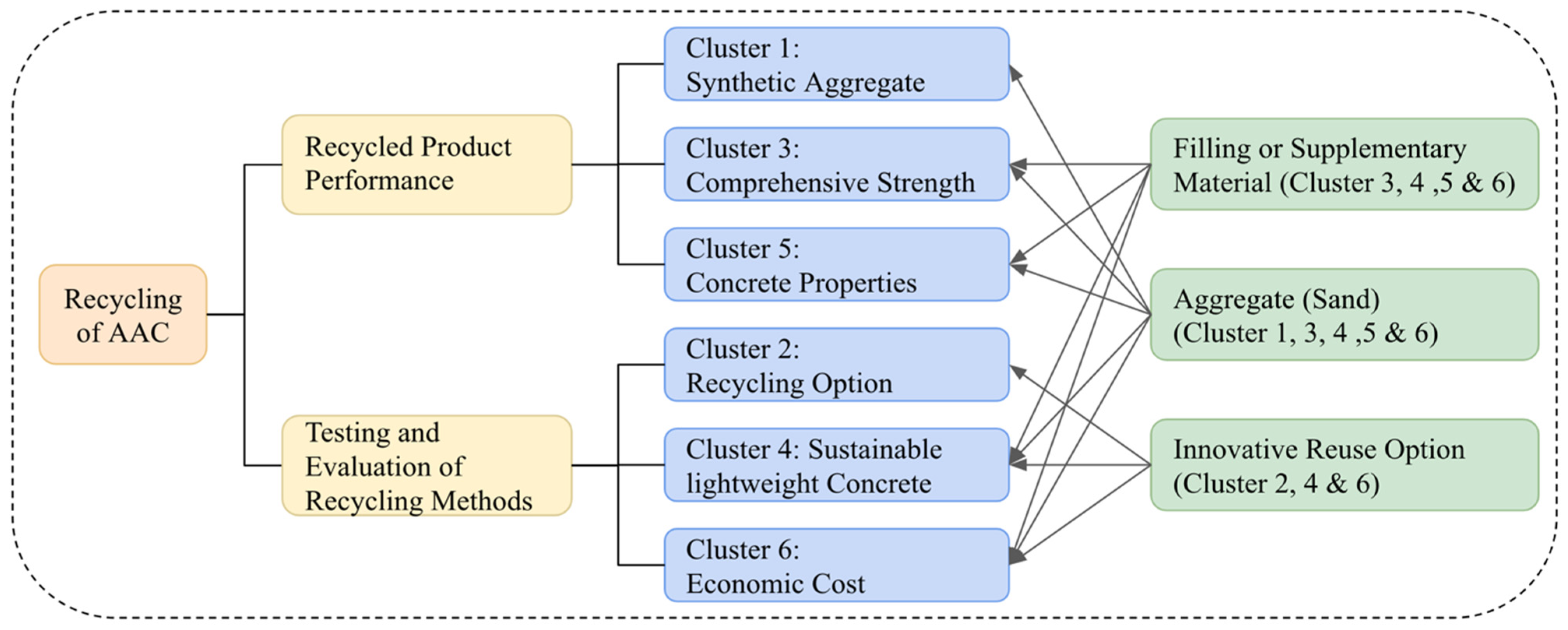
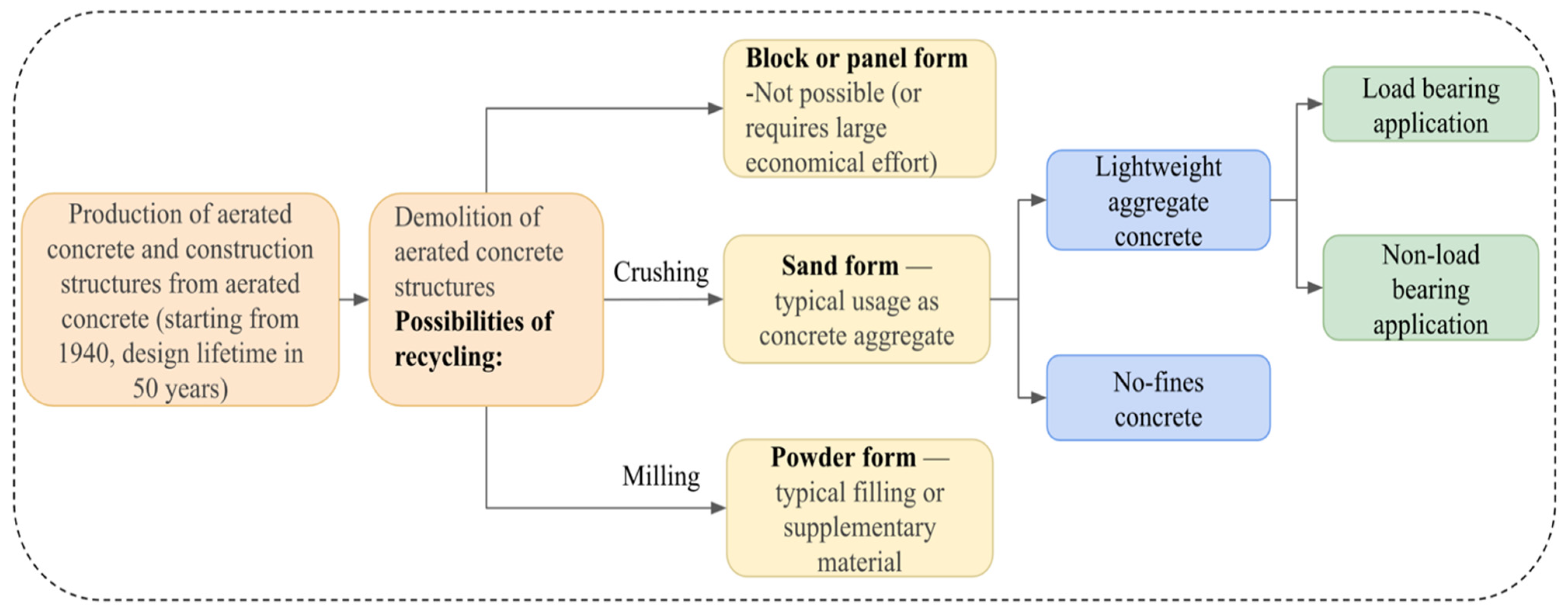
| No. | Frequency | Label | Centrality |
|---|---|---|---|
| 1 | 48 | Autoclaved aerated concrete | 0.32 |
| 2 | 31 | Cement | 0.16 |
| 3 | 31 | Compressive strength | 0.08 |
| 4 | 30 | Strength | 0.14 |
| 5 | 29 | Microstructure | 0.13 |
| 6 | 29 | Fly ash | 0.11 |
| 7 | 21 | Waste | 0.13 |
| 8 | 19 | Performance | 0.08 |
| 9 | 19 | Mechanical property | 0.04 |
| 10 | 18 | Aggregate | 0.12 |
| 11 | 16 | Concrete | 0.18 |
| 12 | 16 | Ash | 0.06 |
| 13 | 15 | Aerated concrete | 0.16 |
| 14 | 14 | Slag | 0.07 |
| 15 | 13 | Construction | 0.08 |
| 16 | 13 | Hydration | 0.03 |
| 17 | 12 | Fly ash | 0.11 |
| 18 | 10 | Behaviour | 0.08 |
| 19 | 10 | Powder | 0.01 |
| 20 | 8 | Recycled aggregate | 0.04 |
| Cluster ID | Cluster Size | Cluster (LSI) | Silhouette | Label (Mutual Information Index) |
|---|---|---|---|---|
| 1 | 30 | Synthetic aggregate | 0.811 | Raw material (0.83) |
| 2 | 29 | Recycling option | 0.811 | Waste (1.4) |
| 3 | 27 | Compressive strength | 0.993 | Partial replacement (0.11) |
| 4 | 23 | Sustainable lightweight concrete | 0.915 | Foamed concrete (0.15) |
| 5 | 16 | Concrete properties | 0.996 | Physical properties (0.03) |
| 6 | 16 | Economic cost | 0.971 | Energy-efficient material (0.34) |
| Characteristics | CAC | AAC |
|---|---|---|
| Silt carrying capacity (Cs/%) | <1 | 3.34 |
| Void fraction (v/%) | >42 | 69.10 |
| Specific surface area (Sw/cm2/g) | >2 × 104 | 8.1 × 105 |
| Piled density (Pp/g/cm3) | <1.0 | 0.53 |
| Apparent density (Pap/g/cm3) | 1.4–1.8 | 1.71 |
| Porosity (P/%) | 53% | 89.21% |
| Removal rate of TOC within 3.5 h | 68% | 66.8% |
| Removal rate of NH3-N within 3.5 h | 49.4% | 95.55% |
| Removal rate of TN within 3.5 h | 25.6% | 41.56% |
| Removal rate of PO43− within 3.5 h | 42.8% | 57.55% |
| References | Secondary Materials | Replacement | Achievement |
|---|---|---|---|
| [91] | Waste aluminium dust | Foaming agent | Every 15.6 g of aluminium dust can replace 1 g of aluminium powder. |
| [92] | Municipal solid waste incineration ash | Sand and fly ash | 20% sand replacement rate, 10% fly ash replacement rate. |
| [93] | Recycled wood fibre | Additive | Improvement of brittleness and low fracture toughness. |
| [94] | Agriculture and industrial solid wastes | Cement | Higher mechanical properties appear in the addition of blast furnace slag. |
| [95] | Recycled shale gas drilling cuttings | Cement | 40% fly ash replacement rate. |
| [96,97] | Rice husk ash | Quartz sand | 27 °C reduction in autoclave temperature, 22% increase in strength. |
| [98] | Copper tailings | Quartz sand | 40% sand replacement rate. |
| [99] | Lead-Zinc tailings | Siliceous materials | Lead-Zinc tailings incorporation of AAC at 62% mass ratio. |
| [100] | Coal gangue and iron ore tailings | Sand | Optimal calcination temperature was approximately 600 °C. |
| [101] | Gold tailings | Siliceous materials | Gold tailings incorporation of AAC at 62% mass ratio. |
| [102] | Basic oxygen furnace slag | Sand | 15 wt.% replacement using the basic oxygen furnace slag. |
| [103] | Desulfurization slag | Sand | Using 0.17 M NaOH(aq) to replace water or calcining the De-S slag in advance both improved the foaming of mortars. |
| [104,105] | Iron ore tailings | Siliceous materials | Iron ore tailings incorporation of AAC at 62% mass ratio. |
| [106] | Ceramic polishing slag | Sand | The best weight ratio of slag paste, cement, and lime is 14.02:1.13:1.17. |
| [107] | Desulfurization wastewater and sludge | Water | 40% water-saving rate. |
| [108] | High-volume calcium coal gangue waste | Sand | 58% incorporation of high-volume calcium coal gangue waste; 40% cost savings. |
| [109,110] | Crushed waste oyster shell | Natural sand | 30% natural sand replacement rate. |
| Research Directions | Previous Research | Limitations | Research Gaps |
|---|---|---|---|
| Comprehensive Characteristic Study | Studies have examined the characteristics of recycled AAC products, including some mechanical and thermal properties. | Long-term durability; intrinsic reaction mechanisms (e.g., fluidity variations, shrinkage) remain poorly understood. | In-depth investigations into long-term performance, microstructural changes, and behaviour under varied environmental conditions to support reliable, high-performance recycled AAC products. |
| Integrated Production Standards | Research often explores specific parameters (e.g., fixed replacement rates, particle sizes, or cement types) for recycled AAC production. | Approaches are fragmented, overlooking the complex interplay of materials and conditions, and lacking holistic guidance for industry. | Systematic studies considering broader variables and conditions, and development of clear, adaptable production standards to enable scalable, industrial implementation. |
| Enhancement of Recycling Techniques | Current recycling processes rely on high-energy crushing and grinding; technologies like process modelling and minimum quantity lubrication are known. | High energy consumption increases costs and undermines environmental benefits, limiting competitiveness of AAC recycling. | Need to refine existing technologies and develop novel, low-energy processes to improve efficiency, lower emissions, and make AAC recycling more sustainable and economically viable. |
| Operational Standards for Pollutant Management | Laboratory research has explored recycled AAC as a heavy metal adsorbent and as biofilters for water eutrophication and methane emissions. | Applications remain at experimental stage; no industrial-scale implementation; operational parameters and protocols are undefined. | Need to establish detailed operational standards and evaluate regeneration, performance, and economic feasibility under real-world conditions to enable pollutant management applications at scale. |
| Hybrid Materials for Road Construction | Mixed materials incorporating AAC waste have shown benefits like improved frost resistance and breathability. | Standalone AAC particles are unsuitable due to low strength and chemical instability; existing studies assess only individual properties, not holistic performance. | Comprehensive evaluation of mechanical, chemical, and environmental behaviour of hybrid road materials, and optimisation of mixing ratios and application parameters for durable, cost-effective solutions. |
| Sustainable AAC with Recycled Materials | Significant efforts have introduced secondary materials into AAC to improve sustainability, reduce costs, and enhance resource efficiency. | Challenges include material variability, contamination risks, and maintaining durability; quality control is difficult. | Need to optimise material formulations, assess environmental risks, and ensure compliance with standards to facilitate broader adoption of sustainable AAC products in commercial construction. |
Disclaimer/Publisher’s Note: The statements, opinions and data contained in all publications are solely those of the individual author(s) and contributor(s) and not of MDPI and/or the editor(s). MDPI and/or the editor(s) disclaim responsibility for any injury to people or property resulting from any ideas, methods, instructions or products referred to in the content. |
© 2025 by the authors. Licensee MDPI, Basel, Switzerland. This article is an open access article distributed under the terms and conditions of the Creative Commons Attribution (CC BY) license (https://creativecommons.org/licenses/by/4.0/).
Share and Cite
Wang, S.; Zhang, G.; Gunasekara, C.; Law, D.; Tan, Y.; Sun, W. A Scientific Review of Recycling Practices and Challenges for Autoclaved Aerated Concrete in Sustainable Construction. Buildings 2025, 15, 2453. https://doi.org/10.3390/buildings15142453
Wang S, Zhang G, Gunasekara C, Law D, Tan Y, Sun W. A Scientific Review of Recycling Practices and Challenges for Autoclaved Aerated Concrete in Sustainable Construction. Buildings. 2025; 15(14):2453. https://doi.org/10.3390/buildings15142453
Chicago/Turabian StyleWang, Shuxi (Hiro), Guomin Zhang, Chamila Gunasekara, David Law, Yongtao Tan, and Weihan Sun. 2025. "A Scientific Review of Recycling Practices and Challenges for Autoclaved Aerated Concrete in Sustainable Construction" Buildings 15, no. 14: 2453. https://doi.org/10.3390/buildings15142453
APA StyleWang, S., Zhang, G., Gunasekara, C., Law, D., Tan, Y., & Sun, W. (2025). A Scientific Review of Recycling Practices and Challenges for Autoclaved Aerated Concrete in Sustainable Construction. Buildings, 15(14), 2453. https://doi.org/10.3390/buildings15142453





_Zhang.png)



